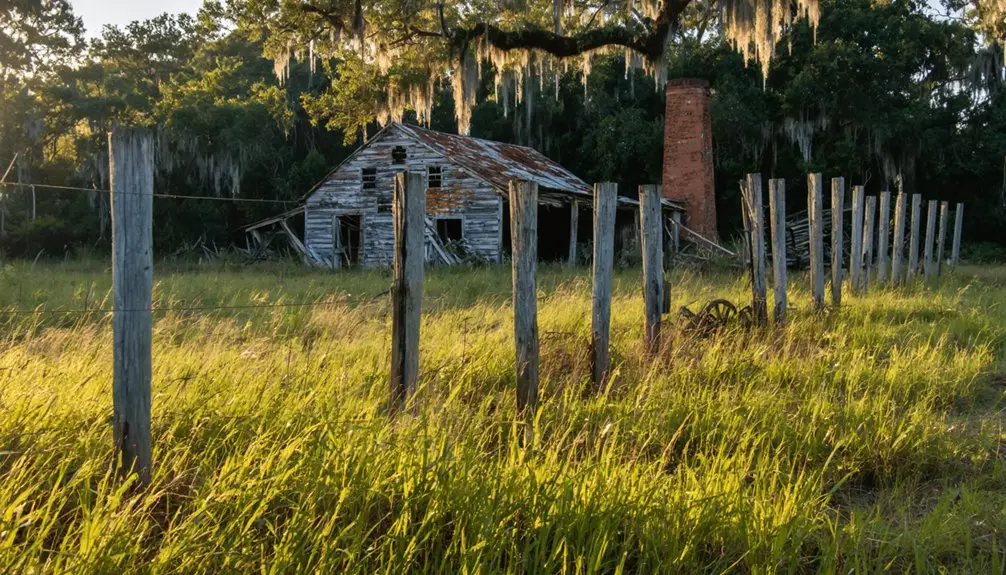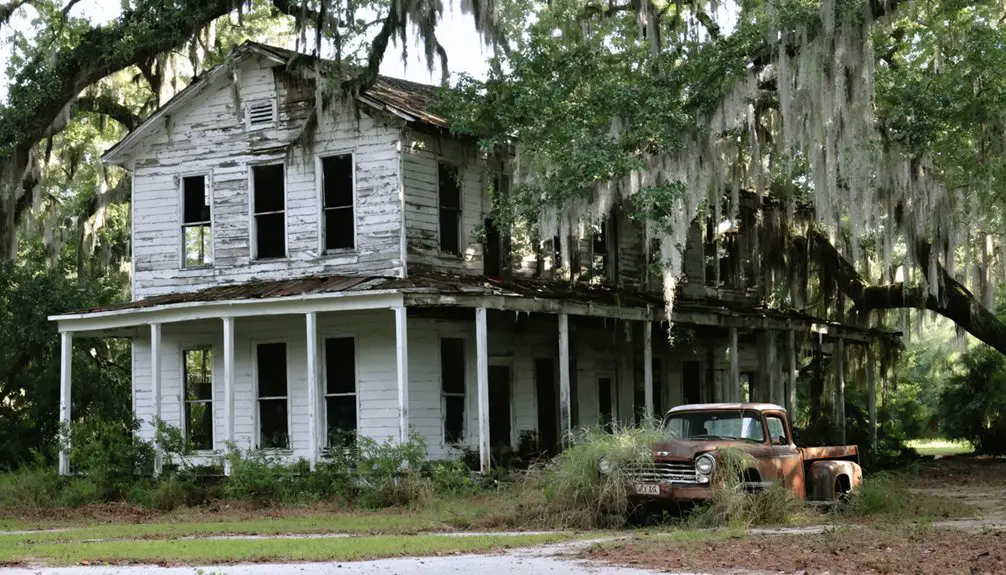You’ll find Slavia’s ghost town remnants near modern-day Oviedo, Florida, where Slovak Lutheran immigrants from Cleveland established their settlement in 1911. They purchased 1,200 acres to escape factory life and preserve their cultural heritage through farming. While urban sprawl and Hurricane Ian’s flooding accelerated its decline, St. Luke’s Lutheran Church and the historic cemetery still stand as monuments to this once-thriving Slovak community’s spirit and determination.
Key Takeaways
- Slavia transformed from a thriving Slovak Lutheran farming community established in 1911 into a ghost town due to urban development pressures.
- The settlement’s decline accelerated after Hurricane Ian’s flooding in 2022, leading to widespread home abandonment.
- Original community structures remaining include St. Luke’s Lutheran Church building and a cemetery containing founding families’ tombstones.
- The former 1,200-acre settlement near Oviedo, Florida, was built around agriculture, particularly celery farming and citrus production.
- Urban sprawl from nearby Winter Park and Oviedo led to increasing property values, forcing farmers to sell their land.
The Birth of a Slovak Lutheran Settlement
While many European immigrants settled in America’s industrial cities during the early 1900s, a group of Slovak Lutherans from Cleveland, Ohio chose a different path in 1911.
Seeking freedom from factory life and urban temptations, these immigrants formed the Slavia Colony Company to establish an agricultural community in Florida. Their migration motivations centered on creating a healthier environment for raising families and preserving their Slovak Lutheran heritage.
Slovak immigrants sought rural refuge from city life, hoping Florida’s farmland would help preserve their cultural identity and family values.
Under the leadership of Martin Stanko and Rev. Leopold Jarosi, the company purchased 1,200 acres near Oviedo, Florida for roughly $17,400. The community became a thriving hub for citrus and celery production.
This community organization effort, supported by Cleveland’s Holy Trinity Slovak Lutheran Church, aimed to transform industrial workers into farmers. They’d found their promised land – a place where their children could grow up working the soil rather than manning assembly lines. Their guiding principle was the slogan Spat ku gazdovstvu, meaning “Back to the farm.”
Religious Foundations and Cultural Identity
As the spiritual bedrock of Slavia’s identity, St. Luke’s Lutheran Church has anchored this faith community since its establishment in 1912. You’ll find that eight original signatories founded the church, which quickly became the settlement’s heart for both spiritual guidance and cultural preservation.
While most Slovaks traditionally practiced Catholicism, Slavia’s settlers embraced Lutheran teachings, reflecting their Protestant Reformation heritage. You’ll see this influence in the church’s 1939 brick structure, where stained glass windows feature reformer Jan Hus and other significant Lutheran symbols. The church was constructed at a remarkably modest cost of $7,500 in that year.
The Missouri Synod Lutheran congregation established St. Luke’s Lutheran School, ensuring their children received education aligned with their religious values. Through outreach ministries and the Lutheran Haven Retirement Center, the church continues to unite descendants across Seminole County, preserving their unique Slovak Lutheran legacy. The Carroll McKenney Foundation has documented and preserved this rich religious history through interviews and historical photographs.
Agricultural Dreams in Central Florida
When Slovak settlers purchased 1,200 acres of central Florida land for $17,400 in 1911, they envisioned transforming the untamed wilderness into a thriving agricultural community.
In 1911, determined Slovak pioneers saw beyond Florida’s wild landscape, dreaming of cultivating prosperity from untamed soil.
You’ll find their initial agricultural innovations included diverse ventures in citrus, turpentine, watercress, and lumber. When the soil proved unsuitable for citrus, they pivoted to celery farming, which sparked significant economic transformations throughout the region.
The devastating freezes of the 1890s had already taught local farmers the importance of crop diversification, making the Slavic settlers’ varied approach particularly wise.
The Duda family emerged as prominent celery producers, while other families tended livestock and various crops. Alongside them, Paul Lukas and Mary Klimek established their Slavia Colony Company to help pioneer land clearing and farming in the area.
You’d have seen children working weekend shifts on the farms, while the railroad carried Slavia’s produce to surrounding towns.
As times changed, these resourceful farmers adapted again, with operations like Duda Farms diversifying into commercial sod and Lukas Nursery evolving into a leading garden center.
Daily Life in Early Slavia
Though the Slovak settlers left behind industrial Cleveland for Florida’s promise, their daily life in early Slavia centered on faith, farming, and tight-knit community bonds.
You’d find families rising at dawn to work their fields, adapting European farming methods to Florida’s challenging soil and climate. The Lutheran church, particularly Saint Luke’s, served as the community’s heart, where you’d join fellow settlers for services and gatherings that preserved Slovak cultural traditions.
You’d witness the strength of cooperative spirit in how families supported each other, from sharing agricultural knowledge to maintaining the town’s basic infrastructure, including the water tower. The remnants of this community can still be seen today in the Celery Fields area.
The A. Duda & Sons building stood as a symbol of the settlers’ entrepreneurial drive, while community gatherings at church helped maintain cultural connections through language, festivals, and shared religious observances.
The Path to Abandonment
Despite the strong communal bonds that initially defined Slavia, urban sprawl from neighboring Oviedo and Winter Park began altering this once-vibrant Slovak settlement into a ghost town by the mid-20th century.
Urban encroachment brought new roads and residential subdivisions, pressuring original farmers to sell their land as property values soared. The devastating effects of Hurricane Ian flooding in 2022 accelerated the area’s decline, forcing many remaining residents to permanently abandon their homes. Similar to how phosphate mining ended Brewster’s community life in 1962, these demographic changes led to rapid depopulation as descendants moved away.
While the church building and cemetery remain as historical anchors, most original homesteads now stand abandoned, marking Slavia’s shift from thriving settlement to ghost town.
The closure of essential services like Stanko’s Store and the diminishing role of St. Luke’s Lutheran Church further weakened community ties.
You’ll find that economic shifts hit the community hard – small family farms couldn’t compete with large commercial operations, forcing younger generations to seek work in cities.
Architectural Remnants and Historical Sites
If you’re exploring Slavia’s architectural heritage today, you’ll find St. Luke’s Lutheran Church stands as the most prominent historical structure, having evolved from its modest 1910s beginnings into a modern complex with a school and retirement center.
The original church building’s location near what’s now St. Luke’s Cemetery off Chapman Road marks the spiritual heart of the former Slovak settlement. Local Lutheran Slovak immigrants established the community in 1911, seeking a new life in Florida.
Throughout the surrounding area, you’ll discover vacant century-old homesteads that showcase early 20th-century rural Florida architecture, though many now stand in various states of deterioration.
Original Church Building Remains
The original church building of Slavia stands as a tribute to the early Slovak Lutheran settlers who established their community in 1911.
Located near today’s cemetery off Chapman Road, this historic structure first served as the central hub for community gatherings, initially utilizing turpentine shacks before a proper building was constructed.
The architectural significance of the church building lies in its humble origins and century-old presence, marking the spiritual and social center of the original Slavia colony.
You’ll find physical remnants of this historic site within the cemetery grounds, where tombstones bearing Slovak names tell the story of the founding families.
While Slavia has become a ghost town, the church’s legacy lives on through St. Luke’s Lutheran Church and School, preserving the settlers’ commitment to faith and education.
Abandoned Homestead Structures
Scattered ruins and weathered foundations are all that remain of Slavia’s original homestead structures, which once housed the ambitious Slovak farming community in the early 1900s.
You’ll find these abandoned structures gradually disappearing into Florida’s lush landscape, with nature reclaiming what settlers built over a century ago.
As you explore the homestead history, you’ll discover:
- Simple wooden frame houses that served as primary residences, now reduced to deteriorating foundations and partial wall remnants
- Agricultural outbuildings like barns and storage sheds, mostly collapsed but still marking former farmstead locations
- Scattered debris fields containing period artifacts – broken glass, rusted metal, and weathered bricks – offering glimpses into the settlers’ daily lives
The wooden structures’ shallow foundations and Florida’s humid climate have accelerated their decay, leaving only fragments of this once-thriving community.
Modern Echoes of Slovak Heritage

Despite Slavia’s conversion into a ghost town, modern echoes of its Slovak heritage remain deeply woven into the region’s cultural fabric through surviving institutions, family businesses, and annual commemorations.
You’ll find this cultural preservation most evident in St. Luke’s Lutheran Church, which continues to serve as a spiritual anchor for Slovak descendants.
Local enterprises like A. Duda & Sons and Lukas Nursery carry forward the names and entrepreneurial spirit of original settler families.
The community legacy lives on through descendants who, though dispersed throughout Seminole County, maintain strong ties to their ancestral roots. They gather regularly to honor their heritage through historical commemorations and family reunions.
While physical structures may have faded, Slovak-American cultural identity persists through oral histories, genealogical research, and active documentation efforts by local historians.
Frequently Asked Questions
What Happened to the Original Slovak Families Who Left Slavia?
You’ll find that many Slovak families preserved their heritage while moving to urban areas, though specific records don’t track their family migration patterns after leaving the settlement.
Are There Any Remaining Businesses From Slavia’s Early Days?
You’ll find several historic businesses tied to early settlers still operating: Duda Farms (now focused on sod), St. Luke’s Lutheran Church, Lukas Nursery, and Tesinsky Automotive all maintain their original family connections.
Did Slavia Have Its Own Cemetery for the Settlers?
Though you’d expect a ghost town to lack proper burial customs, St. Luke’s Cemetery served as Slavia’s significant burial ground, where settlers established their final resting place near Chapman Road, preserving their cultural heritage.
What Natural Disasters or Events Contributed to Slavia’s Decline?
You won’t find hurricane impacts or natural disasters driving Slavia’s decline. Instead, economic shifts, urban development, and changing demographics gradually transformed the community as younger residents sought opportunities in nearby cities.
How Many Original Slovak Homes Are Still Standing in Slavia Today?
Like scattered puzzle pieces from the past, you’ll find virtually no original Slovak architecture standing today. Historical preservation efforts reveal just a handful of non-residential structures remain from the founding era.
References
- https://theclio.com/entry/36621
- https://www.tresbohemes.com/2022/10/czech-settlement-at-slavia-florida/
- https://floridatraveler.org/2017/04/25/floridas-unique-ghost-towns-are-not-invisible/
- https://en.wikipedia.org/wiki/List_of_ghost_towns_in_Florida
- https://campus.sdh.gba.gov.ar/florida-ghost-town-uncover-hidden-history
- https://theclio.com/entry/77826
- http://www.geocities.ws/krdvry/hikeplans/slavia/planslavia.html
- https://stars.library.ucf.edu/cfm-images/4557/
- https://cmfmedia.org/2010/03/history-of-our-communities-–-slavia-florida/
- https://storymaps.arcgis.com/stories/1d66510701c34847a67e24bcda21d6d1



